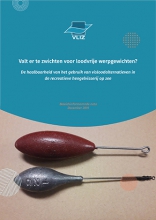
Lead is a heavy metal that, because of its favourable physical properties, is used in many applications, including (recreational) fishing. However, lead is a persistent, bioaccumulative and toxic element (PBT) whose emissions and losses must be reduced as much as possible. To this end, VLIZ publishes a new Policy Information Brief (BIN) that zooms in on the lead issue with regard to fishing products but also identifies opportunities regarding the use of lead-free alternatives.
Lead (chemical element 'Pb') is a naturally occurring heavy metal that is used in all kinds of applications because of its softness, malleability, low melting point (327 °C) and relatively low cost. The metal is found in automotive batteries, jewellery, old paints, ammunition, building materials, electronic products, cosmetics, etc. But also in commercial and recreational fishing it is a popular material to work with. In spite of this, Europe has included lead in the list of priority pollutants in the field of water policy for which measures must be taken to reduce discharges, emissions and losses into surface waters. Chemical pollution of surface waters is a threat to the aquatic environment and to aquatic organisms. Lead is also a PBT, in other words, lead particles and oxides are constantly accumulating in every form of life and are not biodegradable in the environment.
The present report (only available in Dutch), entitled “Valt er te zwichten voor loodvrije werpgewichten – De haalbaarheid van het gebruik van visloodalternatieven in de recreatieve hengelvisserij op zee”, focuses specifically on the use of lead by recreational anglers. Despite the fact that recreational sea angling is expected to be rather a small player with regard to the lead influx in Belgian marine waters, it is important to have the necessary ambition within each of the sectors that contribute to this chemical pollution to reduce or stop the influx of lead in the (marine) environment in the short term. The report focuses (1) on national and international policy in this area, (2) on the (health) risks associated with the use and the self-manufacturing of lead fishing weights, (3) takes a closer look at the results of a pilot project with lead-free fishing weights and (4) discusses the perception of lead-free alternatives from the recreational fishing community’s point of view on the basis of the results of a survey. In this way, this publication implements measure 29D 'Stimulating alternatives to fish lead' of the programme of measures for the Belgian marine waters.
The note states that the users of lead-free fishing weights assess the properties of the latter as moderately positive to positive. Only in a limited number of cases, a reduction in catches was reported. As a result, fishermen are often prepared to use alternative fishing weights. However, adequate alternatives do not exist for all disciplines and a thorough stimulus in terms of research, development and innovation is recommended towards angling producers. The challenge lies in the development of 'affordable' non-hazardous alternatives that approximate the characteristics of lead. Preferably, non-hazardous biodegradable alternatives should be used and other heavy metals and traditional plastics should be excluded as much as possible. A phasing out of lead fishing weights can be obtained by means of a stimulating, but non-binding principle, by analogy with the Dutch 'Green Deal 222' model or by means of a legally binding framework (e.g. according to the Danish model, i.e. a ban on sales and import). The report also states that it is important to obtain an adequate and substantiated estimate of the current lead loss on an annual basis within the present framework. This can be done at wreck level (estimate of loss of wreck fishery, excluding historical lead loss) or can be embedded in the marine recreational fishing monitoring programme (www.recreatievezeevisserij.be).
The full report can be downloaded here.